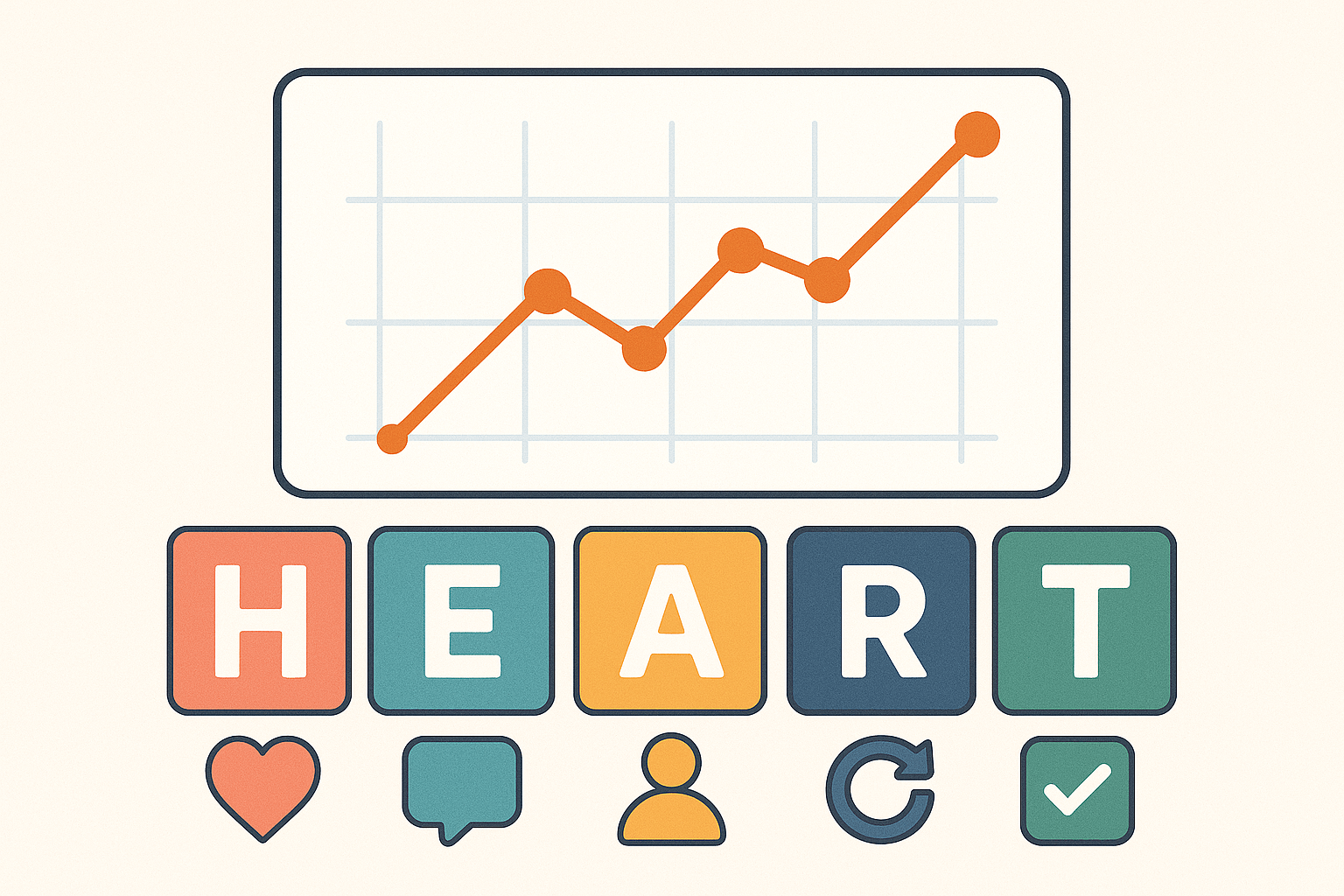The HEART Framework is a powerful UX metrics framework developed by Google to help product teams measure and improve user experience effectively. By focusing on five key dimensions—Happiness, Engagement, Adoption, Retention, and Task Success—the HEART Framework enables organizations to track user satisfaction, behavior, and product performance through actionable, data-driven insights.
What is the HEART Framework?
Introduced by Google UX researcher Kerry Rodden, the HEART Framework is designed to provide a structured approach to measuring user experience at scale. It helps teams define clear, measurable goals aligned with both user needs and business objectives. By evaluating user experience across its five core dimensions, the framework supports continuous product improvement and informed design decisions.
The Five Dimensions of the HEART Framework
Each dimension of the HEART Framework focuses on a unique aspect of the user-product relationship:
| Dimension | Definition | Example Metrics |
|---|---|---|
| Happiness | Measures user attitudes and satisfaction with the product. | Satisfaction surveys, Net Promoter Score (NPS) |
| Engagement | Quantifies the frequency and depth of user interactions. | Session length, frequency of use, active users |
| Adoption | Tracks how many new users start using a product or feature. | Number of new sign-ups, feature activation rate |
| Retention | Measures how many users return over time. | Repeat visits, churn rate |
| Task Success | Evaluates usability and efficiency in completing tasks. | Task completion rate, error rate, time on task |
How to Implement the HEART Framework
Follow these five steps to successfully apply the HEART Framework to your UX measurement strategy:
- Define UX Goals: Identify which HEART dimensions align with your product’s objectives.
- Identify Signals: Determine user behaviors or attitudes that indicate progress toward each goal.
- Select Metrics: Choose quantifiable, trackable metrics for these signals.
- Collect Data: Use analytics tools, surveys, and usability testing to gather data.
- Analyze & Iterate: Regularly review metrics to inform design improvements and product decisions.
Benefits of Using the HEART Framework
- Provides a holistic, user-centered view of UX performance.
- Enables data-driven decision-making across product teams.
- Helps prioritize UX improvements that align with both user satisfaction and business goals.
- Simplifies communication of UX impact to stakeholders.
- Supports long-term tracking of product success and user experience.
Example: Applying the HEART Framework to a Mobile Finance App
Goal (Engagement): Increase the number of users interacting with budgeting features weekly.
Signal: Frequency of logins and task completions within budgeting tools.
Metric: Percentage of active users engaging with budgeting features at least three times per week.
After implementing UI improvements, the team observed a 25% increase in engagement and higher user satisfaction scores, demonstrating the value of HEART-driven design.
Common Use Cases for the HEART Framework
- Measuring user satisfaction after launching new features.
- Prioritizing UX design decisions based on user behavior.
- Aligning UX goals with business KPIs during product redesigns.
- Tracking improvements following usability testing.
- Evaluating long-term product success in Agile development environments.
Challenges and Limitations of the HEART Framework
- Not all five dimensions apply to every product or feature.
- Requires strong cross-functional collaboration and clear data ownership.
- Subjective metrics like Happiness can be difficult to directly link to business outcomes.
- Overemphasis on quantitative data may overshadow qualitative user insights if not balanced.
Tools and Methods for Measuring HEART Metrics
- Surveys: CSAT, NPS for measuring Happiness.
- Analytics Platforms: Google Analytics, Mixpanel, Amplitude for Engagement and Retention.
- In-App Telemetry: Tracks Adoption and Task Success.
- A/B Testing Tools: Validate the impact of design changes.
- Usability Testing & Session Recordings: Hotjar, UserTesting for qualitative context.
Frequently Asked Questions (FAQ)
What makes the HEART Framework unique compared to other UX frameworks?
It combines both attitudinal and behavioral metrics across five comprehensive dimensions, enabling a balanced and scalable approach to UX measurement.
Can the HEART Framework be used for mobile apps?
Yes, it is highly effective for mobile, web, and desktop applications alike, adaptable to various product types and user interactions.
How does HEART relate to the Goals-Signals-Metrics framework?
HEART defines the broad UX goals, while Goals-Signals-Metrics breaks down those goals into specific signals and measurable metrics, providing a practical implementation method.
Is the HEART Framework suitable for small startups?
Absolutely. While it originated at Google, the framework’s flexibility allows teams of all sizes to tailor it to their needs and resources.
Conclusion
The HEART Framework is an essential tool for UX professionals aiming to measure and improve user experience in a structured, scalable way. By focusing on Happiness, Engagement, Adoption, Retention, and Task Success, product teams can make informed, data-driven decisions that enhance both user satisfaction and business outcomes.
Start applying the HEART Framework today to unlock deeper insights into your users and create products they love.

